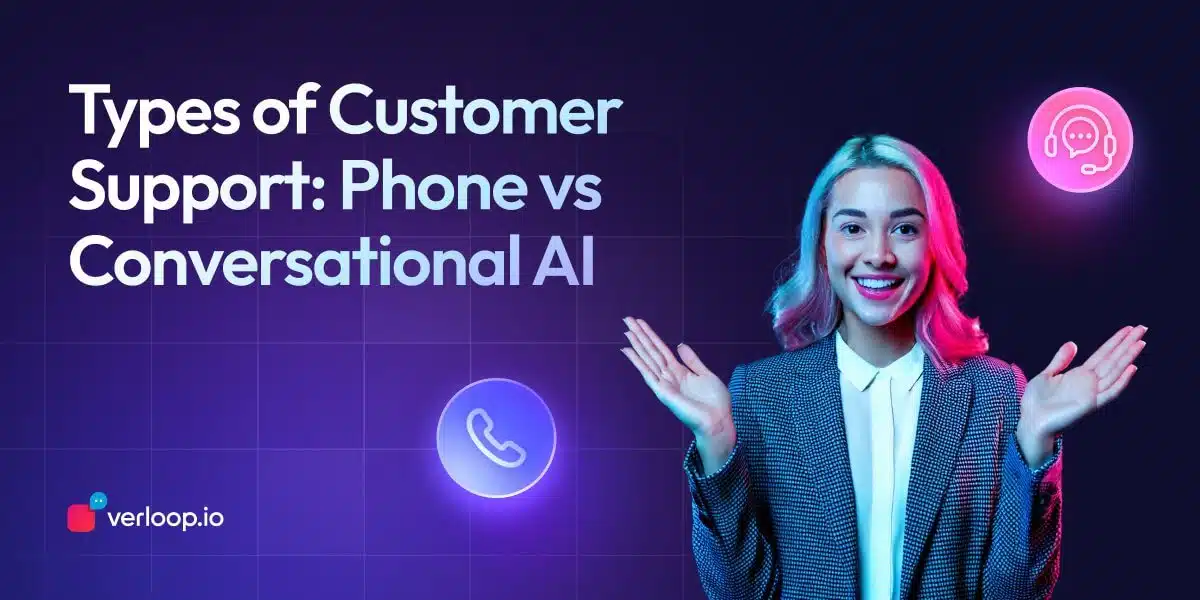How your Business Benefits from Early Adoption of Voice AI?
- February 3rd, 2025 / 5 Mins read
-
Harshitha Raj

How your Business Benefits from Early Adoption of Voice AI?
- February 3rd, 2025 / 5 Mins read
-
Harshitha Raj
The introduction of Siri in 2011 marked a pivotal moment in human-computer interaction. Since then, voice AI has rapidly evolved, progressing from handling simple keyword-based queries to addressing complex questions with remarkable accuracy. This evolution has not only enhanced user experiences but also resulted in significant time and cost savings for businesses.
Recognising the potential of voice AI early on offers a substantial competitive advantage. By adopting this technology early, businesses can experiment, learn from mistakes, and unlock its full potential. This approach fosters innovative thinking and allows routine tasks to be delegated to AI, freeing resources to focus on core business objectives. As a result, voice AI can become a powerful catalyst for success.
This blog will explore current voice AI trends, future possibilities, and the compelling advantages of early adoption.
Suggested reading: Voice AI: What is it and How Does it Work?
Understanding Voice AI Calls
Voice AI is a specialised area of conversational AI that enables computers to understand and respond to human voice input in a natural and meaningful way. It leverages Natural Language Processing (NLP) to interpret spoken language and Machine Learning (ML) to refine responses over time, aiming to create human-like interactions.
Components of Voice AI
Let’s discuss some of the voice AI components:
Speech Recognition
Speech recognition is the foundational component of voice AI. It’s a technology that transforms spoken language into a format computers can understand. This process involves labelling data, identifying patterns within it, and applying a recognition algorithm.
The resulting text is then processed by speech-to-text software, enabling the computer to comprehend the spoken message.
Noise Filter
Voice AI effectively identifies and reduces noise in audio signals using signal processing and machine learning. Signal processing breaks down audio into its constituent frequencies and other characteristics, allowing for the identification of noise patterns.
Simultaneously, machine learning algorithms analyse vast datasets to learn noise characteristics in diverse environments. By applying these learned patterns, the system develops strategies to minimise or eliminate noise while preserving speech quality. This technology enhances speech clarity in noisy settings.
Neural Networks
Neural networks are inspired by the human brain and consist of interconnected nodes that recognise patterns in data. They process information, learn from data, and make decisions or predictions. This powerful technology enables computers to perform complex tasks, such as speech recognition and natural language processing, with increasing accuracy and sophistication.
NLP Engine
Voice AI assistants use NLP engines to capture the full context of voice messages. They analyse the intent and sentiment behind the user’s input and generate responses that closely resemble human speech.
Response Evaluation
The voice AI evaluates the quality, effectiveness, and relevance of a response to a given query. It assesses clarity, conciseness, accuracy, completeness, tone, style, and logical structure.
Deliver Response Message
Once dialogue management determines the appropriate response, it is formulated into text using natural language generation. This text is then converted into spoken language through text-to-speech and delivered to the user, completing the interaction.
Voice AI Revolution: Redefining Communication and Interaction
From rudimentary voice recognition to sophisticated conversational AI, we’ve come a long way.
Today, it permeates various aspects of our lives, from smartphones and smart home devices to speakers, offering unprecedented levels of personalized assistance.
Let’s discuss how advanced voice AI has become.
Text-to-Speech (TTS) Technology
TTS is a remarkable advancement in voice AI that accurately converts written text into spoken language. This makes it an invaluable tool for overcoming language barriers and reading difficulties.
It is widely used in various applications, including video games, movies, and TV shows to provide voices for on-screen text. When combined with translation technology, TTS can also deliver spoken translations of foreign languages.
LLM (Large Language Models)
LLMs are sophisticated AI systems capable of understanding and generating human-like text based on provided input. From early rule-based NLP models to leading advancements like BERT and OpenAI’s GPT series, LLMs have evolved dramatically. They now excel at producing coherent and contextually relevant text across a wide range of tasks.
As a result of these advancements, LLMs have revolutionised various industries by enabling sophisticated chatbots, automating content creation, and enhancing data analysis. As research continues, LLM’s efficiency is more likely to improve and ensure their ethical use.
Voice Recognition Technology
AI-powered voice recognition technology has undergone significant advancements recently. This technology accurately converts spoken language into written text.
As a result, communication has become more efficient. People can effortlessly dictate emails, messages, or even lengthy documents without relying on typing.
Voice Search Optimisation
People are increasingly relying on voice assistants like Siri, Alexa, and Google Assistant to find information online. This shift has necessitated a change in website optimisation strategies, requiring websites to cater to voice queries in addition to traditional text-based searches.
Incorporating long-tail keywords and natural language into content is crucial. This approach mirrors the way people speak, increasing the likelihood of a website appearing in voice search results.
AI Voice Translation
Another remarkable advancement in voice AI technology is AI voice translator. It enables real-time translation of spoken words from one language to another.
Hence, significantly breaking down language barriers. This innovation facilitates smoother communication between people from different countries.
Real-time Voice Changers
Real-time voice changers are a fascinating and innovative development in voice AI technology. These tools allow users to instantly modify their voice to mimic various characters, animals, or other sound effects. That adds a playful dimension to interactions. They have become particularly popular among gamers, content creators, and social media users.
Benefits of Early Adoption of Voice AI
Early adoption of voice AI can provide significant advantages for businesses. Here are some key benefits:
Efficient Customer Support
The foundation of customer service often involves repetitive tasks such as answering FAQs, resolving basic issues, data input, and managing emails and tickets. These tasks are both time-consuming and monotonous. Voice AI emerges as a valuable solution by automating these repetitive processes.
Consequently, employees can dedicate their time and skills to complex issues that require human intervention, enhancing overall customer service efficiency.
Foster Innovation
Employees familiar with voice AI are more likely to think creatively about its applications. A deeper understanding of its potential fosters innovative solutions, driving company-wide advancement.
This competitive edge allows organizations to continually explore new possibilities, stay ahead of industry trends, and create growth opportunities.
Enhanced Customer Experience
Voice AI empowers customers with instant, accurate resolutions available 24/7. Customers highly value this accessibility and speed. By providing support in their preferred language and at their convenience, voice AI significantly increases customer satisfaction and overall experience.
Tailored and Automated Customer Interaction
Consumers favour brands that offer personalised experiences. Voice AI excels at delivering this by analysing customer data, including past interactions and purchase history, to understand individual preferences.
Through a combination of speech recognition, natural language processing, and advanced algorithms, it generates automated responses that are tailored to each customer.
Minimised Customer Support Costs
Voice AI reduces customer support costs by efficiently handling a high volume of inquiries at a lower expense.
Additionally, providing relevant and accurate responses enhances customer satisfaction, fostering loyalty and reducing the cost of acquiring new customers.
Assist with Marketing Campaigns
Voice AI is revolutionising marketing by analysing user data to create highly personalised campaigns. By delivering real-time product information, recommendations, and comparisons, it enhances the customer experience. Additionally, voice-activated ads and interactive experiences boost brand visibility and memorability among new customers.
Shortens the Sales Cycle
Voice AI accelerates sales cycles by streamlining business operations and improving lead conversion rates. By enabling rapid engagement with potential customers, it significantly reduces wait times, leading to a smoother and more efficient customer journey.
Also, early-stage automation ensures timely communication, allowing businesses to close deals faster and more effectively.
Stability and Cost-Efficient
Voice AI offers significant advantages in scalability and cost-effectiveness. It can handle an increasing volume of inquiries without requiring additional staff, thereby reducing hiring and training expenses. This scalability enables businesses to support a larger customer base without expanding their workforce, resulting in cost savings and improved service availability.
Challenges in the Adoption of Conversational Voice AI
Conversational Voice AI is already driving a major shift in customer engagement, making interactions more seamless, efficient, and scalable. However, like any emerging technology, businesses may have considerations before full-scale adoption. The key is understanding these factors and leveraging solutions that make implementation smooth and effective.
Scaling Customer Conversations Without Losing Quality
As businesses grow, handling increasing customer interactions becomes complex. Traditional systems struggle to maintain speed and efficiency at scale. This is where Human-Like Voice Agents powered by Conversational Voice AI step in—allowing brands to scale without compromising on personalisation or response quality.
Aligning AI with Brand Identity
Every business has a unique tone and communication style. Ensuring that AI Voice Support reflects this consistently is crucial. With advancements in gen AI voice calls, brands can now train AI models to align with their preferred tone, making customer interactions more natural and personalised.
Optimising for Real-Time, Contextual Responses
Customers expect instant solutions, and AI needs to deliver. Businesses often wonder if AI Voice Support can truly understand complex queries in real time. Thanks to context-aware voice AI calls, modern solutions can track conversation history, intent, and nuances—ensuring accurate and meaningful responses without delays.
Enhancing AI-Human Collaboration
The best customer support combines automation with human expertise. Businesses aren’t choosing between AI and human agents—they’re using both to their advantage. A well-designed Conversational Voice AI ensures seamless handovers, assisting agents by handling repetitive queries while empowering them to focus on high-value interactions.
Ensuring Compliance and Trust
Security and compliance are top priorities for any business. Some organisations may be concerned about privacy when adopting AI-driven communication. The good news? AI Voice Support solutions today are built with enterprise-grade security, compliance frameworks, and robust data encryption—ensuring trust at every step.
Adopting Conversational Voice AI isn’t about overcoming roadblocks—it’s about unlocking new opportunities for efficiency, scalability, and engagement. With technology evolving rapidly, businesses now have access to AI-powered voice solutions that enhance experiences, build customer loyalty, and future-proof support operations.
Integration of Voice AI in Your Business
To successfully integrate voice AI into your business, first establish clear objectives for what you want to accomplish. Define the role of voice AI: Will it enhance customer satisfaction, boost sales, or streamline internal operations?
Next, determine the specific area where voice AI will add the most value, such as handling customer inquiries, processing orders, or scheduling appointments.
Once you have defined your goals and objectives, choose the right platform for integration.
- If improving customer support through voice interactions is your primary goal, Verloop.io is a strong option, as it specializes in customer service automation.
- For general-purpose voice assistants, consider platforms like Siri, Alexa, or Google Assistant.
Design the voice interface to facilitate natural and intuitive conversations between users and the system. To achieve the best results, you may need technical experts for strategic planning.
- They will help you understand how the system will interpret user speech.
- Understand the limitations and capabilities of speech recognition technology.
- Know how to generate natural-sounding speech output.
Integrate your voice assistants with existing systems, such as CRM software, to ensure a cohesive system with smooth data sharing and processing.
Finally, conduct thorough testing to identify areas for improvement. Collect user feedback on the voice experience or conduct surveys, and refine your voice application based on the gathered data and insights.
What Does the Future of Voice AI Hold?
With each decade bringing new technological advancements and applications, the coming years are likely to witness even more. As customers become increasingly accustomed to technology and their expectations soar, adopting voice AI becomes crucial for businesses.
Let’s explore what we can anticipate in the near future.
Smarter AI Assistance
With the increasing use of smartphones, consumers are more likely to utilise voice assistants within their mobile applications. This will enable users to navigate applications more easily and efficiently through voice commands. It would create a more comfortable experience for those less tech-savvy.
As It offers a more accessible and user-friendly interface.
The global voice assistant market is projected to exceed a valuation of US$47,366.3 million by 2032. This highlights the immense potential and demand we will encounter.
IVR Systems and Call Management
NLP and speech recognition capabilities have revolutionised IVR systems, enabling them to understand and respond to customer voices. In the near future, IVRs will become even more sophisticated, capable of comprehending longer phrases and more complex requests.
Additionally, these systems will automatically record and transcribe conversations, simplifying the process for agents to upload information to CRM systems.
Ethical and Responsible AI
As AI becomes increasingly integrated into our lives, there will be a growing emphasis on the morality and trustworthiness of the technology’s output. This will necessitate a strong focus on privacy, security, and transparency. Developers will create systems that are fair, impartial, and respectful of user data.
Consequently, the future will likely see a safer, more socially responsible, and ethically compliant voice AI.
Integration of Large Language Models (LLMs) in Voice Assistants and Speech AI Technologies
Voice AI with LLMs is significantly enhancing AI technologies by improving call summaries, offering real-time translation, and providing valuable prompts for sales and support teams during live conversations.
They are automating repetitive tasks in a way that feels more natural and less mechanical. This makes them increasingly essential components of AI systems.
We can anticipate the seamless integration of advanced LLM capabilities into both speech AI technologies and voice assistants, leading to substantial performance improvements and enhanced user experiences.
Stay Ahead of the Curve: Embrace Voice AI with Verloop.io
The rise of voice AI marks a pivotal shift in technology, enhancing customer interactions and operational efficiencies across various sectors. As we’ve seen, from sophisticated speech recognition to advanced voice search optimization, the benefits of adopting voice AI early are substantial. Companies that integrate these technologies can expect improved customer support, personalized experiences, and cost savings.
Verloop.io exemplifies how voice AI can be harnessed to transform customer service. By automating routine tasks and providing real-time, contextually relevant responses, Verloop.io helps businesses enhance their support capabilities and operational efficiency. As voice AI continues to evolve, embracing reliable platforms will be crucial for businesses aiming to stay ahead and deliver exceptional service in an increasingly voice-driven world.
So go ahead and schedule a demo.






